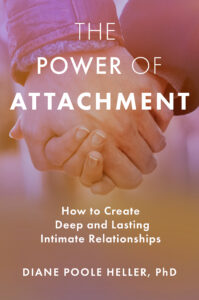Be sure to listen to Diane’s Podcast conversation with Michael Ostrolenk
as they discuss The Power of Attachment.
 When I began speaking with Sounds True about a written book following my audiobook, Healing Your Attachment Wounds: How to Create Deep and Intimate Relationships, I wasn’t sure what to expect, as I have always considered myself more proficient with the spoken than the written word. Nevertheless, we started the journey to The Power of Attachment, which I actually started over 12 years ago, but somehow, it never felt finished to me. I found that progress often stalled with new research and trying to contain everything about attachment theory between the covers of a single book.
When I began speaking with Sounds True about a written book following my audiobook, Healing Your Attachment Wounds: How to Create Deep and Intimate Relationships, I wasn’t sure what to expect, as I have always considered myself more proficient with the spoken than the written word. Nevertheless, we started the journey to The Power of Attachment, which I actually started over 12 years ago, but somehow, it never felt finished to me. I found that progress often stalled with new research and trying to contain everything about attachment theory between the covers of a single book.
For years, I had a vision that encompassed providing valuable clinical knowledge for therapists while making content about attachment theory digestible for the average partner, parent, or friend who was looking for answers about attachment, as well. I believe that sharing information that helps each of us move toward secure attachment can not only improve our individual lives, but also improve the communities where we live and provide global healing, as well.
This knowledge is so vital, and I am so grateful to have worked with Sounds True, whose competent staff helped me design the architecture of the book and sculpt it into an organized guide for anyone seeking the tools to heal attachment injury for themselves, loved ones, or clients.
Because so much of our trauma or attachment injury becomes stored in implicit “not conscious yet” memory, it was important for me to include experiential exercises for the reader to become more in touch with an embodied sense of their wounding and also to highlight their experiences of a healthy relationship.
Creating specific Corrective Experiences to address the core wounds at the heart of any insecure attachment patterning gives us a direction to heal old wounds as well as a way to meet unmet needs that may have occurred in childhood or later. One of the challenges in doing this in written form is making sure people understand that it’s not meant to replace therapy when needed. It’s also meant to build in some safeguards that encourage the reader to take steps that are manageable and not too overwhelming.
By engaging experientially in the Corrective Experiences, we can discover and build experiences that can help us integrate secure attachment knowledge into our personal lives. Learning Secure Attachment Skills (SAS) changes how we walk around in the world; we can exude a sense of attunement, safety, and support for our relationships as well as cultivate a healthy internal relationship with ourselves.
As readers become more familiar with what attachment style or adaptation they most relate to—and many of us have a mix of styles—the attempt is to also give them more awareness as well as many ways that they can help themselves and/or support others. We begin to see each other in our relationship struggles with more compassion and can practice more appropriately supportive responses that lead to growth and healing for all concerned.
My journey from teaching to writing
Most of my professional life has been in a teaching role. I’m a visual learner and incorporate many visual examples into my live teaching programs to help the audience remember the points I make about trauma, nervous system arousal, connection, and brain function. Many therapies focus on putting pressure on the attachment system, usually for diagnostic reasons. This approach never sat right with me for therapy with clients. It was essential for me to address the attachment injury more gently to avoid re-traumatization.
Sometimes, I find it helpful to use physical objects or even toys as metaphors for teaching concepts related to healing. One example is using a toy Slinky to demonstrate a client in a high-arousal state. If you imagine holding the slinky in a way where it’s tight towards the center to reflect the constriction of trauma, it’s wise that you don’t release it all at once, or it will spring back out forcefully and snap back like a rubber band that could create even more constriction and exaggerates the contraction. We practice releasing it just a little at a time from each end. Many therapies start in the middle where the impact of the trauma is most intense, but by unwinding a little at each end until you reach the center–ground zero of the trauma, it creates a safer and more contained way to manage and release the over-arousal related to the trauma. No one forgets the Slinky demonstration, but writing a book takes the visual element out of the equation.
Years of teaching in front of an audience has allowed me to test a variety of approaches, gauge the response of the participants, and instantly adjust my strategy if it’s not landing in the way I expected. Writing a book is committing to a single approach that feels final. And one huge factor that impacted me during writing The Power of Attachment was that finality. I was concerned that the book would not reach people in the way that I hoped because everyone learns differently. I found myself thinking about how different people would consume the book and if my message was clear.
I’m honored by the response so far and the feedback that I’ve received from readers, including my colleagues.
In order to move from the live teaching process to the writing process, I pored over many of the transcripts from workshops and programs I’ve presented, pulling resources that would translate more effectively to the book.
Sounds True was invaluable during this process. They helped me shape the sections of the book, formulate the most intuitive organization, and polish the final product. They also had the knowledge necessary to promote a book by supporting me in gathering endorsements, initiating promotions, and suggesting content for marketing videos.
Why now was the right time for The Power of Attachment
Attachment is germane to the human experience whether you are talking about spirituality, religion, relationship . . . everything! Trauma work is essential to help us navigate hurdles and the bumps and bruises of relational experiences. It’s my belief that we increase our capacity for love and intimacy when we heal trauma and learn to develop and enhance secure attachment. People do the best that they can, and with the tools to reshape our relationships and heal trauma, we increase our ability to have profoundly intimate and long-lasting relationships that support and heal ourselves and each other.
When we tap into our capacity to heal ourselves, we can begin to heal on a larger, global scale that can impact and reshape the future of the human experience. I obviously believe that this work is essential and have dedicated most of my professional career to spreading the word through my attachment program for therapists called DARe (Dynamic Attachment Re-patterning experience), which is a progressive four-series approach to healing each of the attachment adaptations for our clients in a safe, supportive way that helps heal attachment injuries toward regaining skills and capacities for Secure Attachment. We have regular live trainings in the Boulder, CO area each year and around the country.
It’s my hope that everyone this book touches will connect with it in some way and that it will help people on the road toward healing the trauma wounds and attachment injuries that keep us from connecting on that essentially deep human level that fuels the soul and nourishes our lives.







